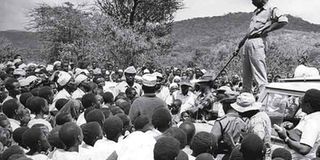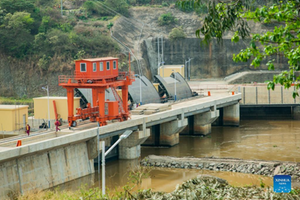Bodyguard reveals where Nyerere hid during mutiny

What you need to know:
Peter Bwimbo narrates how he took President Nyerere and Rashidi Kawawa to Salanga Village and knocked at the house of Sultan Kizwezwe who received them kindly
Dar es Salaam. The Tanganyika army mutiny of January 20, 1964 is one of the most extensively covered events in the history of Tanzania.
Several books as well as academic papers have been written detailing the event. The media has also been extensively covering the events on annual basis since the sad event happened 54 years ago.
Some aggrieved soldiers mutinied to press for higher wages, better working conditions and the Africanisation of the army. During their tense negotiations with then-Defence minister Oscar Kambona, the soldiers demanded 150 per cent immediate salary increase.
The mutiny that took place eight days after the Zanzibar Revolution led to the disbanding of the Tanganyika Rifles (TR) and the creation of the Tanzania People’s Defence Forces (TPDF).
The one aspect that has been the subject of speculation by most of the accounts on the mutiny was where exactly President Julius Nyerere was taken the night of the mutiny. Nyerere and his security detail spent two nights and three days hiding.
Different accounts have different versions of where President Nyerere and Vice President Rashidi Kawawa had been hiding. Many accounts just mention that Nyerere went hiding somewhere in Kigamboni or even further at Mji Mwema.
In fact some accounts claim that at Mji Mwema Nyerere took refuge at Judge Abdulla Mustapha’s home.
Yet other accounts claim that Nyerere sought refuge at a Catholic bishop’s residence
But a more credible account of where President Nyerere was taken following the army mutiny has been revealed by Peter Bwimbo, who doubled as the head of the Presidential Security Unit (PSU) and Mwalimu’s bodyguard.
Bwimbo started out as a police officer in the colonial police force. He was then transferred to the Special Branch, which was the British colonialists’ secret police. As Tanganyika attained internal self-government status in May 1961 and Nyerere became Prime Minister, Bwimbo was again transferred to the leaders protection unit, created within the Special Branch, which was responsible for the security of the new leaders.
Bwimbo was then transferred to the unit and was assigned as the bodyguard of Prime Minister Nyerere.
He continued with that role after independence and later rose to the rank of deputy director general of the Tanzania Intelligence and Security Services, which was created in 1963 following the disbanding of the Special Branch.
In the highly detailed autobiography, published in 2016 and written in Swahili, Bwimbo explains how he took the two leaders to a hiding place.
In his book Bwimbo says he took both Nyerere and Kawawa to Salanga Village, near Mji Mwema in Kigamboni.
His aim was to take them to the government rest house, where the President used to go at weekends to rest, but he changed his mind when it became clear they would not reach there before sunrise.
“So as daylight started chasing the night away we stopped and knocked at the house of Sultan Kizwezwe. “
He narrates how he took them there:
“I received a telephone call in the dead of the night-- at 2am -- from Leon Kazimili, who was the officer-on-duty in charge of the PSU stationed at the State House, Magogoni.
“It must be noted that soldiers of the Tanganyika Rifles were the ones manning the gate at State House. But the PSU had also an office at the gate and a few officers stationed working in a 24 hour shift.
“Kazimili told me in the brief telephone conversation that the chief of the army, Brigadier Patrick Sholto Douglas, who was a British national, had telephoned him and warned him that there were signs that a foreign army had attacked the Colito (now Lugalo) Barracks.
He instructed him to wake up President Nyerere and give him the information since he, Brigadier Douglas, could not reach him.
“I hurriedly left my home, at Upanga, near United Nations Road and headed to the State House in my small Mercedes Benz sedan 190 with registration number TD 5067. I passed through Ocean Road (now Obama Drive) and then turned right towards Luthuli Road, reaching the State House’s main gate at 2:20am.
“When I arrived I found my officers had already woken up President Nyerere and Prime Minister Kawawa, who were now standing outside in the front lawn. The residence of the Prime Minister was then at the State House compound.
“After a few minutes my boss, the director general of Intelligence and Security Services Emilio Charles Mzena and Police Commissioner (title that is now equivalent to IGP) Elangwa Shaidi arrived.
“But none had any further information on the mutiny or on the next course of action to take. In that case I knew I had to think fast of how best to protect the leaders. There was no time to waste.
“At 2:45am I led the President and Kawawa outside the State House through the back, northern, gate. Mzena and Shaidi remained at the State House. I made sure no one else knew where I was taking the two leaders due to security reasons. “The State House walls were being manned by police officers. So I took with me two uniformed, but unarmed police constables. It must be emphasised that only the TR soldiers manning the main State House gate were armed. Neither the PSU nor the police officers at the State House were armed.
“We walked to the Magogoni ferry landing area where we took a pontoon that was there.
“I told the pontoon operators who were there that the two leaders were hurrying for an emergency meeting at the Kivukoni College in Kigamboni. While we were starting to cross the creek to Kigamboni we heard some noise coming from the main gate of the State House, meaning that the rioting soldiers had already arrived at the State House.
“When they reached Kigamboni, I told the pontoon operators not to take the pontoon back to Magogoni because the two leaders will need it to cross back to the State House after the meeting. “My aim was to reduce the chances of the mutineers to pursue the President, once they discover that he was not at the State House.
“We started walking towards Mji Mwema. It must be noted that at that time the road was a rough, gravel road and there were huge thickets along the road.
“We passed Kigamboni and Mji Mwema. As we approached Salanga Village it was already dawn. I knew continuing with the journey posed a security risk for the two leaders. And since the houses were dispersed at Salanga I knew if we entered one of the house it would be difficult for other households to know whether there were guests in the village.
“We knocked at the house of Sultan Kizwezwe. He received us kindly.
“Meanwhile as news of the mutiny spread, chaos erupted in the city, with looting and the killings of some people of Asian origin.
“For about 24 hours no one else knew where the two leaders were. This was the most difficult period for the two leaders during their time in leadership. There were no telephones in the village or any other means of knowing what was going on in town. We reached a stage when we started mulling the idea of taking them to Mafia Island where they could easily get into contact with Dar es Salaam.
“But we had to abandon the idea after calm returned to the city and the possibility of going back to the State House seemed real.
“It was only the next day, on January 21, that the minister of State Bhoke Munanka arrived at Salanga Village. He was alone. After I made sure that his coming would not, unnecessarily, expose the two leaders I took him to the house where the two leaders were. He briefed them of the situation, received some instructions and went back to town to tell the others that he had met the President and Kawawa and that they were alive, well and in a secure place.
Later in the day some supplies for the two leaders were brought to Salanga through Mbagala.
“For food we consumed what was there especially fruits that were at Kizwezwe’s garden.
“On January 22, after the mutineers had calmed down we took the leaders back to the State House. Soon the soldiers who had been promoted by mutineers following the evacuation of British officers, arrived at the State House to introduce themselves. They included Elisha Kavana and Francis Hingo Ilogi. They came with armed bodyguards, which caused quite a stir at the State House.
“But everything passed without incident and they soon returned to Colito Barracks.”
Bwimbo further narrates that after the soldiers who were promoted by the mutineers left the State House, President Nyerere made a tour of the city to see the rate of damage caused by the chaos. At this point the mutiny had not yet been quelled.
“The British soldiers that President Nyerere had requested started shelling the Colito Barracks at dawn on January 25 and later succeeded in disarming and arresting mutineers, “ Bwimbo says in the book.
The British troops stayed till March when they were replaced by Nigerian soldiers, who stayed till September. The mutineers were arraigned in court and jailed.




